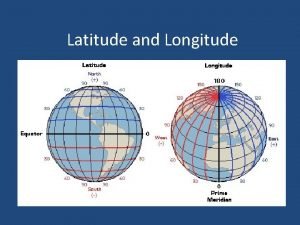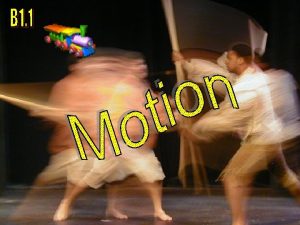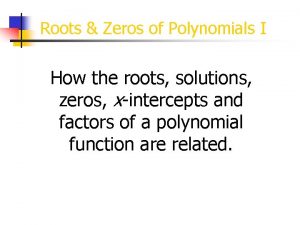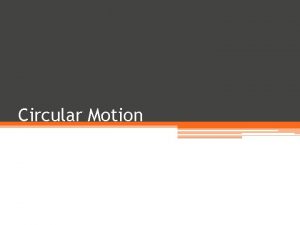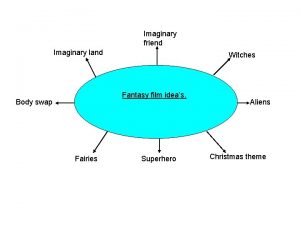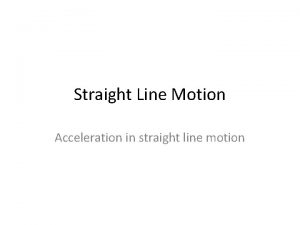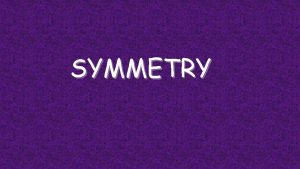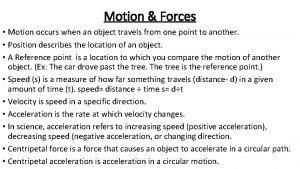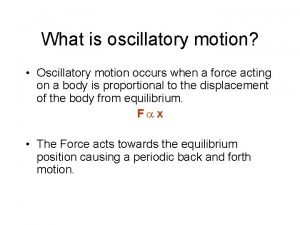Motion occurs when an imaginary line joining an























- Slides: 23


Motion occurs when an imaginary line joining an object to a reference point changes in length, direction or both The term uniform motion describes an object that moves at a constant rate in the same direction. True uniform motion is nearly impossible to maintain in real life situations due to forces such as friction, wind resistance etc. . .

t = 1. 2 s 5. 0 m The car moved a distance of 5. 0 m in a time of 1. 2 s. It did not exhibit uniform motion because it sped up and slowed down. The average speed of the car is defined as a change in distance during a time interval. vavg = average speed (m/s) Δd = distance travelled (m) Δt = time elapsed (s) The Δ is the greek letter delta and means “change in. ”

Practice Problems p. 128 1) A huge ocean wave, or tsunami, travels a distance of 4. 0 x 106 m in 3. 6 x 104 s. Calculate the average speed of the tsunami. 1. 1 x 102 m/s 2) A Concorde airplane could fly at an average speed of 694 m/s. Calculate how long it would have taken the Concorde to fly around the world, which is approximately 4. 00 x 107 m. 5. 76 x 104 s 3) An electric train is traveling at an average speed of 6. 9 m/s for 4. 0 s. Calculate the distance traveled by the train. 28 m


The independent variable is also called the manipulated variable. It is the one that the experimenter changes, or has control over. It is always plotted on the horizontal, or x-axis. When looking at a data table, the independent variable will be seen to increase by regular intervals.

The dependent variable is also called the responding variable. It is the one that the experimenter measures. It’s value depends on the independent variable. It changes in response to the change that the experimenter makes to the manipulated variable. It is always plotted on the vertical, or y-axis. When looking at a data table, the dependent variable will NOT be seen to increase by regular intervals.

For example, to determine the density of a liquid, a student measures the mass of various volumes of the liquid. Volume is the independent variable because the experimenter set it, and it increases by regular intervals. Volume (ml) Mass (g) 10. 0 26. 7 20. 0 53. 6 30. 0 80. 6 40. 0 107. 1 50. 0 134. 0 Mass is the dependent variable because the experimenter measured it and it does not increase by regular intervals.

All graphs MUST have a title, of the y vs x format. units label units Each axis must have the appropriate label and the symbol (abbreviation) for the units, in brackets. Each point that you place on the graph must be circled.

Slope (m) measures the amount of steepness of a given line segment. Slope may be defined as the vertical change (rise) divided by the horizontal change (run). slope = m

Pick any two points on the graph. Label the points as (x, y) Substitute the values into the slope formula.

Lines with a positive slope rise to the right. Lines with a negative slope fall to the right. Horizontal lines have a slope of zero. ∆y = zero no vertical change! Vertical lines have an infinite slope. ∆x = zero no horizontal change!

(m) If there is a clear pattern among the points, draw a best fit line that comes as close as possible to most of the points. Best fit line may be straight or curved. (N)


Interpolation and Extrapolation

A motorboat is traveling at a constant speed. A person on the shore is recording the distance the boat travels away from the first marker buoy every 2. 0 s. Distance from First Marker d (m) 0. 0 0 2. 0 10 4. 0 20 6. 0 30 8. 0 40 10. 0 50 text p. 129 A distance vs time graph can be plotted to analyze the motion of the boat. Distance vs Time Distance (m) Time t (s) Time (s)

Distance (m) Distance vs Time change in distance slope change in time average speed = Time (s) The slope of a line on a distance-time graph is equal to the average speed of the object.

Distance (m) Distance vs Time = 5. 0 m/s (0, 0) Time (s) (6. 0, 30) Don’t forget to round to the right number of sig digs, baby! So, the boat is moving at a constant rate of 5. 0 m/s.

Distance (km) Distance vs Time text p. 130 1 2 3 The graph shows the motion of three different cars. Despite different slopes, all three cars have a constant speed. This is because the slope of their line does not change. Time (h) Car 1 is traveling at a constant speed, faster than car 2 (slope is steeper). Car 2 is traveling at a constant speed, slower than car 1 (slope is not as steep). Car 3 is stopped. The slope is zero, therefore the speed is zero. The distance does not change as time passes.

0. 0 5. 00 2. 0 5. 00 4. 0 5. 00 6. 0 5. 00 8. 0 5. 00 10. 0 5. 00 The boat is exhibiting uniform motion, so that means the speed does not change. text p. 130 A horizontal line has a slope of zero, and that means that the speed stays constant as time passes. Speed vs Time Speed (m/s) Time When Speed of the Boat Passes Boat as it Passes Marker Each Marker t (s) v (m/s) Time (s)

The slope of a line on a speed-time graph indicates that an object is either speeding up or slowing down. Speed vs Time Speed (m/s) A text p. 131 Object A is increasing its speed (positive slope). B Time (s) Object B is decreasing its speed (negative slope).

The area under the line of a speed-time graph determines the distance the object travels. Speed (m/s) Speed vs Time A boat is travelling at a rate of 10 m/s for 5. 0 s. The area under the line forms a rectangle. 10 area = length x width Time (s) 5. 0 = 50 m The boat travels a distance of 50 m.

ü read student reference 7: graphing pages 472 - 477 ü Line master 1 – Graphical analysis of uniform motion (average speed) ü read pages 126 – 133 ü B 1. 1 Check and Reflect page 135 #’s 1 – 13 SHOW YOUR WORK FOR ALL MATHAMETICAL CALCULATIONS!!!!
 Imaginary line joining points of equal elevation
Imaginary line joining points of equal elevation An imaginary line joining the points of equal elevation
An imaginary line joining the points of equal elevation Latitude horizontal
Latitude horizontal Indicates that you can draw an imaginary line
Indicates that you can draw an imaginary line Where did the missouri compromise imaginary line run
Where did the missouri compromise imaginary line run Body cavities
Body cavities Vertical plane mirror
Vertical plane mirror Eg subject code
Eg subject code The poet robert herrick compares his life with
The poet robert herrick compares his life with Range of motion
Range of motion Simple harmonic motion
Simple harmonic motion An object in motion stays in motion
An object in motion stays in motion Chapter 2 motion section 1 describing motion answer key
Chapter 2 motion section 1 describing motion answer key The main difference between speed and velocity involves
The main difference between speed and velocity involves Section 1 describing motion
Section 1 describing motion Describing and measuring motion worksheet answer key
Describing and measuring motion worksheet answer key Section 1 describing motion
Section 1 describing motion Humankind has always searched in vain
Humankind has always searched in vain Imaginary roots
Imaginary roots Roots of a polynomial
Roots of a polynomial Solutions roots zeros
Solutions roots zeros Matlab imaginary number
Matlab imaginary number My name is drugs poem
My name is drugs poem An ideal gas is an imaginary gas
An ideal gas is an imaginary gas


